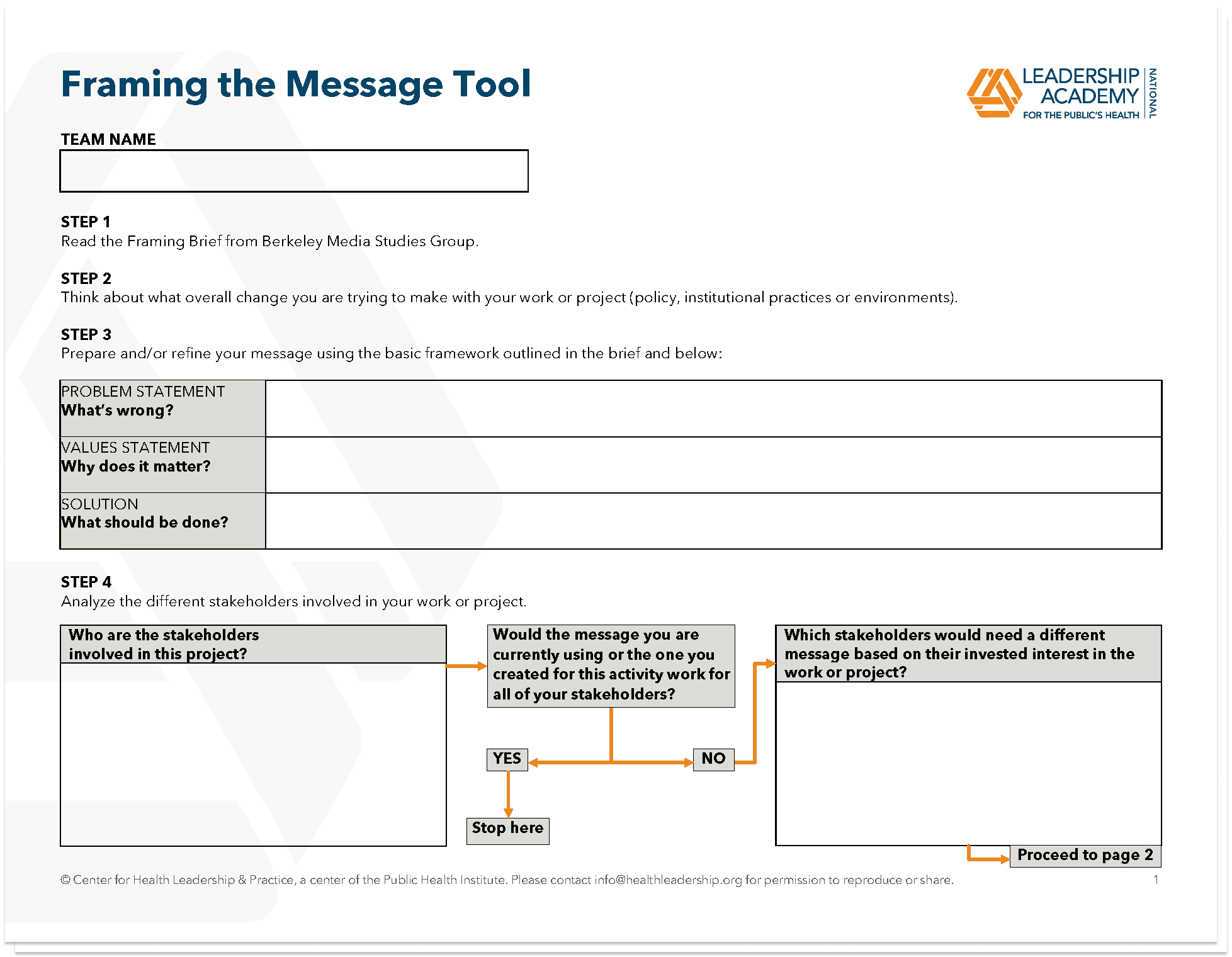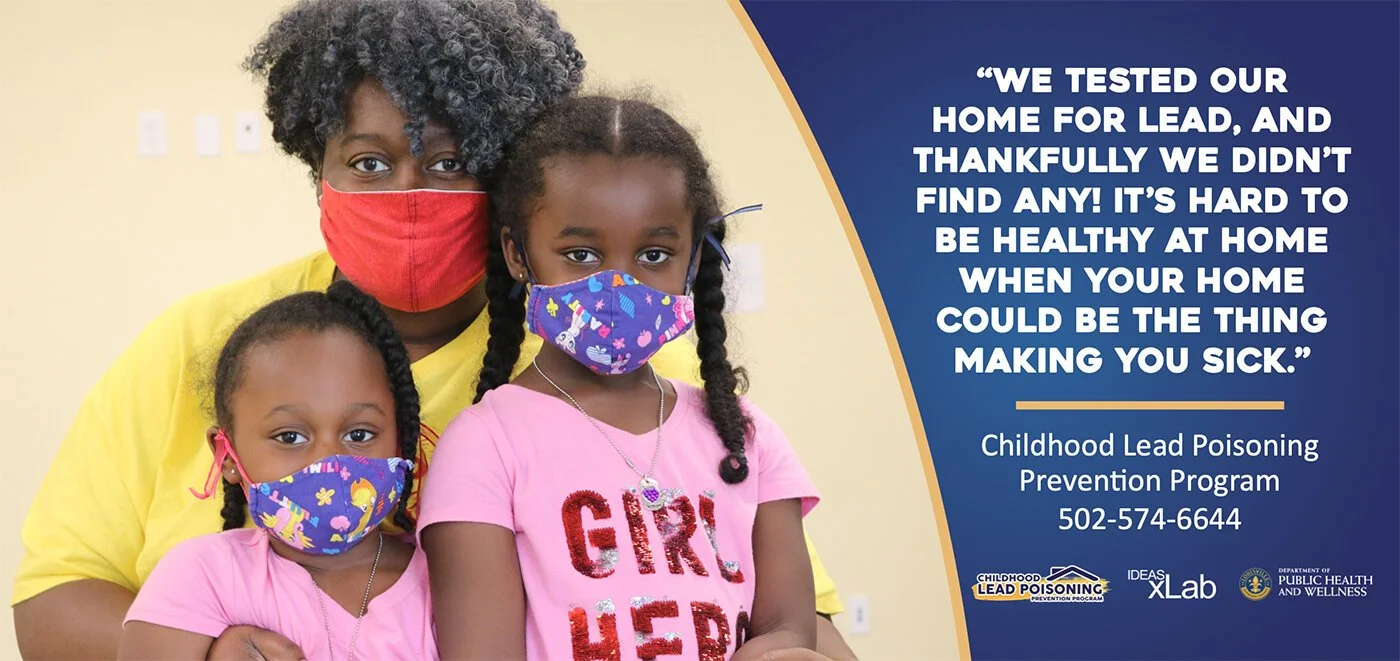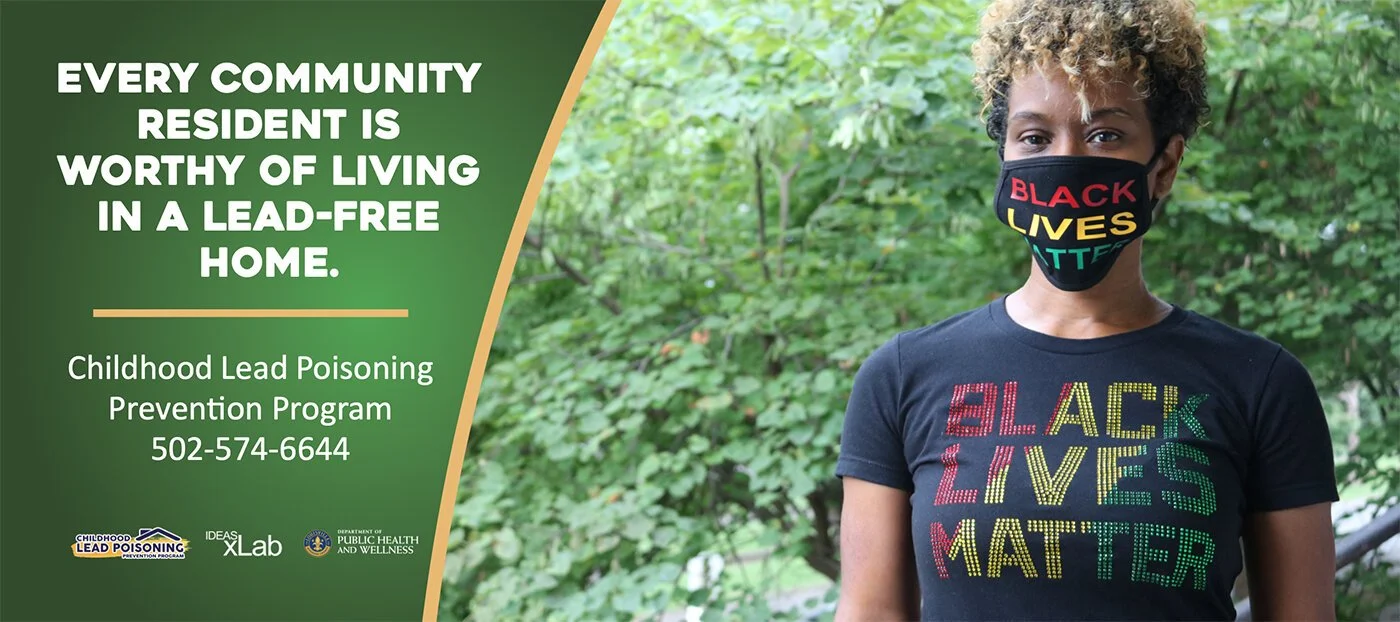CALAPH C8
Framing the Message
Includes: Framing the Message Tool, required materials to review, webinar, and recommended resources.
Craft messages that speak to your audiences
How we communicate our public health messages matters. How can we share our messages with stakeholders, communities, and funders in ways that will resonate with them? The Framing the Message Module is structured to help teams effectively frame their messages for various audiences.
ASSIGNED
Monday, February 10
DUE
No submission
Get the Framing the Message Tool
The Framing the Message tool is structured to help teams frame their messages for various audiences. Prior to the Framing the Message Webinar, teams should:
Review both the framing brief and article shared in the Required Materials to Review section of this module.
Download and being working on the Framing the Message Tool.
After attending the Framing the Message webinar, teams can make adjustments to the tool as needed.
Required Materials to Review
Please review the materials below prior to working on the Framing the Message Tool and attending the Framing the Message webinar.
Both materials were produced by the Berkeley Media Studies Group (BMSG). BMSG is a nonprofit organization dedicated to expanding advocates' ability to improve the systems and structures that determine health, and like CHLI, is a project of the Public Health Institute.
Framing Brief: What Surrounds Us, Shapes Us: Making the Case for Environmental Change
This framing brief supports preparation of the Framing the Message tool and sets the stage for making a case for your team’s topic/focus issue with effective language and messaging.
Framing 101
Like the framing brief, What Surrounds Us, Shapes Us, this online article was produced by the Berkeley Media Studies Group. It is a very succinct piece that introduces the topic of framing but looks at it from several different angles.
Module Webinars
CALAPH CORE WEBINAR
Framing the Message
Thursday, March 6, 2025
10:30am - 11:30am PT (60 mins)
This webinar highlighted several case studies that demonstrate the importance of carefully framing a message to achieve community health improvements. Fellows had the chance to reflect on their own Applied Health Leadership Project (AHLP) messages and learn how to frame those messages effectively. Teams also workshopped how to communicate and frame messages for a variety of stakeholders and networks. Prior to this webinar, fellows should have reviewed both the framing brief and article above under Required Materials to Review.
Leadership Reflection Questions
What was your "ah-ha" learning moment of the webinar?
Does your message work with all of your stakeholders? If not, which stakeholders might need to hear a different message? What if the current message doesn't get the buy-in or reaction that you want?
Do your messages reflect community voice? Do your messages speak to advancing health equity?
Your framed message(s) influence(s) your Big Picture and your Network Map.
For your Big Picture: Refine any of the elements now based on what you learned while working on your messages. Is your vision more or less refined now? What did you learn about your pathway that might need to be adjusted? What about your challenges or your stakeholders' challenges? What about your sponsors? What might you need to do to manage up?
For your Network Map: What parts of the map are well positioned to support your message? What areas should be expanded and enriched to advance your message and build a movement around your work?
Recommended Resources
Transforming the Narrative: Health Equity & The Community – A Toolkit
Source: National Network of Public Health Institutes (NNPHI)
Rather than a step-by-step guide to narrative change, this toolkit was designed to compliment narrative change work being done in communities every day to decrease exposure to ACEs and help create more opportunities to achieve health equity. The toolkit offers insight from NNPHI project partners that built and amplified transformative narratives in their communities, as well as resources that will help others build sustainable, cross-sector relationships, and harness grassroots power to assist in achieving health equity in their communities. For health departments and their partners, the toolkit offers a frame to develop more justice-rooted language.
How to Frame a Powerful Social Change Message
Source: Change Conversations
This article reviews the elements of an effect frame and provides further information about how to successfully frame social change messages through the use of several recommended strategies and tools.
How Great Leaders Inspire Action
Source: TED
This Ted Talk with Simon Sinek explains Sinek’s simple but powerful model for inspirational leadership—starting with a golden circle and the question: "Why?" His examples include Apple, Martin Luther King Jr. and the Wright brothers.
10 Ways to Have a Better Conversation
Source: TED
We “frame” our conversations—whether it be with stakeholders or one person. We use information—like the context of how we know them, the environment in which we are communicating, and the topic itself—to determine the way we talk about things and what type of information we share. This short Ted Talk from Celeste Headlee, a host and interviewer, goes into various ways to improve conversation. This talk is geared toward conversations between two individuals, but a lot of this advice can be applied to messaging, even when addressing a larger group of stakeholders.
The Power of Vulnerability
Source: TED
Brené Brown, PhD, LMSW has spent years studying vulnerability, courage, worthiness and shame. This Ted Talk is one of the most watched talks on TED.com, and was shared as a retreat-related resource earlier in the program. It is worth watching again now that we are talking about messaging and communication.
Crafting Richer Public Health Messages Webinar Series
Source: The Network for Public Health Law
Designed for public health practitioners, lawyers, researchers and scientists, government and healthcare officials, and business and community leaders, this three-part webinar series, co-sponsored by the Network and the Center for Public Health Law Research, explores the interdisciplinary messaging teamwork necessary to fashion legal and policy interventions in these politically polarized times. Using concepts and frameworks adapted from both Moral Foundations Theory and the Five Essential Public Health Law Services, the presenters describe fresh approaches and practical examples for convincing lawmakers and the public to adopt new policies during these challenging times.
Archived CHLI Webinars on Framing
Access archived webinars sponsored by the PHI Center for Health Leadership & Impact in partnership with Dialogue4Health. This particular collection of webinars focus on the topics of framing, communication, and narrative change.
Cutting through the Chaos: Reframing Public Health
Recorded: July 11, 2023
Presenter: Julie Sweetland, the FrameWorks Institute
In a moment when the need for strong public health infrastructure should be clear, public health authority is being eroded and public health topics are being politicized. How can we work together to move the narrative in a more productive direction? This session will dive into the framing strategies we all need right now, with examples of how to talk about health equity in conservative contexts, how to rebuild vaccine confidence, and other timely topics.
Media Advocacy As a Tool for Narrative Change
Recorded: June 14, 2022
Presenters: Cinyere Cindy Amobi & Shaddai Martinez Cuestas, Berkely Media Studies Group
Public health professionals across the country have been in the spotlight because of the COVID-19 pandemic. Whether communicating about risk and prevention or advocating for structural change, advocates must evoke a narrative that consistently builds support towards public health goals. Strategic engagement with the news media is a powerful way for advocates to reach decision makers, activate allies and build public support. In this web forum, Berkeley Media Studies Group provides a brief introduction to media advocacy as a narrative change tool public health advocates can use in their work.
FrameWorks Institute 2021 Webinar Series
Part I - Framing Health Equity: Communication Strategies That Work
Recorded: June 30, 2021
Presenter: Julie Sweetland, the FrameWorks Institute
We can’t achieve health equity without moving mindsets past health individualism – and that requires us to conscientiously frame health equity topics. Recent empirical research by the FrameWorks Institute offers evidence-based guidance on how to talk about health equity in ways that resonate broadly. Strategies will be illustrated with findings and examples from a range of health equity topics, including tobacco control, maternal and infant health, oral health, childhood adversity, and more. Viewers will walk away with practical strategies to define issues more effectively, make innovative solutions come to life, and leverage the power of a good explanation.
Part II - Communicating in Conservative Contexts: Strategies for Raising Health Equity Issues Effectively
Recorded: July 13, 2021
Presenter: Julie Sweetland, the FrameWorks Institute
To eliminate health disparities, we need to make progress in states and regions where conservative opinions are the norm. Some ways of talking about health equity topics can backfire in conservative contexts – while others can unlock the door to support for good policy. In this session, the FrameWorks Institute shares pragmatic strategies for navigating toward justice in red-state terrain. Each recommendation is grounded in evidence from empirical research showing that reframing can help to build common ground on even the most divisive public health topics.
ALUMNI SPOTLIGHT
Using Billboards to Share a Community Message
Team quick facts
Team: Louisville Lead Free Community Team
Program Affiliation: NLAPH Cohort 10
Location: Louisville, Kentucky
Project aim: To change and advance policy and practices to proactively remove lead and protect the Louisville community.
Framing strategy
The Louisville Lead Free Community Team participated in NLAPH as part of the tenth cohort during the 2020-2021 program year and was one of the inaugural teams brought in under the Lead-Free Communities initiative. The team continues to build upon their original Applied Health Leadership Project (AHLP) and is now utilizing Lead Hazard Removal grant funding to empower Louisville communities to address lead hazard exposures in the area. The project is directly related to improving health equity and the team continues to investigate Health in All Policies (HiAP) methods for building partnerships.
One of the team’s primary strategies includes an arts-based outreach and education campaign soliciting community voices to create a lead awareness communication plan to increase lead competency from within the community, as opposed to speak “at” the community through more traditional communications methods. As part of this message framing strategy, the team created two billboards (seen here on the right) to share community sourced messages about lead awareness.




